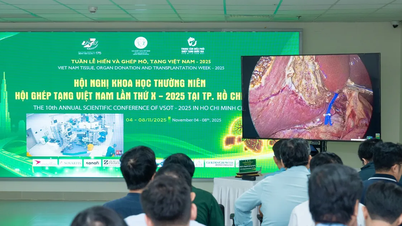
Researchers believe this transcranial illumination method could become a technological bridge between cheap electroencephalography (EEG) and expensive high-resolution MRI - Photo: AI
Scientists at the University of Glasgow (Scotland) have just achieved an unprecedented milestone: successfully shining a beam of light from one side of the human skull to the other. This success opens up hope for a non-invasive brain imaging method that is cheaper and more flexible than current bulky equipment.
Currently, functional near-infrared spectroscopy (fNIRS) is considered one of the cheapest and most portable methods for recording brain activity. However, this technology only penetrates a few centimeters below the scalp, leaving magnetic resonance imaging (MRI) machines as the only option for deeper "sight".
In a study published in the journal Neurophotonics, the team extended the sensitivity of fNIRS by using a higher-power near-infrared laser (still within safe limits), and added a more complex light-harvesting system to detect the tiny amount of photons that pass through the skull.
In a series of tests, only one volunteer, a light-skinned, hairless male, showed light passing completely from one side of the head to the other. The scans took up to 30 minutes and required extremely precise setup conditions.
Despite the limited results, the team says their main goal was to demonstrate the seemingly impossible: passing light through an adult human skull. To do so, they made many sacrifices, including scanning speed, sample size, and control conditions.
Using a computer model built from 3D scans of the skull, the team accurately predicted the photon trajectories. Interestingly, the light did not scatter randomly, but instead followed preferential paths, such as through the cerebrospinal fluid chambers, which are more transparent. This finding opens up the possibility of targeting deeper brain regions by changing the position of the external light source.
fNIRS technology has many advantages: it is compact, low cost, can be brought to the community, unlike expensive and fixed MRI machines in hospitals. If fully developed, the new technology can be used for early screening of strokes, brain tumors or monitoring brain damage right at the scene.
Researchers believe that this transcranial illumination method could become a technological bridge between low-cost electroencephalography (EEG) and high-resolution but expensive MRI. In the future, portable brain imaging devices with high penetration will contribute to bringing neurological diagnosis closer to people, especially in remote areas.
The research is now seen as a foundation for developing next-generation brain imaging devices, both for pathological diagnosis and for studying intellectual development in children and neurodegeneration in the elderly.
Source: https://tuoitre.vn/dot-pha-chieu-duoc-anh-sang-xuyen-nao-nguoi-ma-khong-can-phau-thuat-20250623092819004.htm



































































































![Dong Nai OCOP transition: [Article 3] Linking tourism with OCOP product consumption](https://vphoto.vietnam.vn/thumb/402x226/vietnam/resource/IMAGE/2025/11/10/1762739199309_1324-2740-7_n-162543_981.jpeg)













Comment (0)